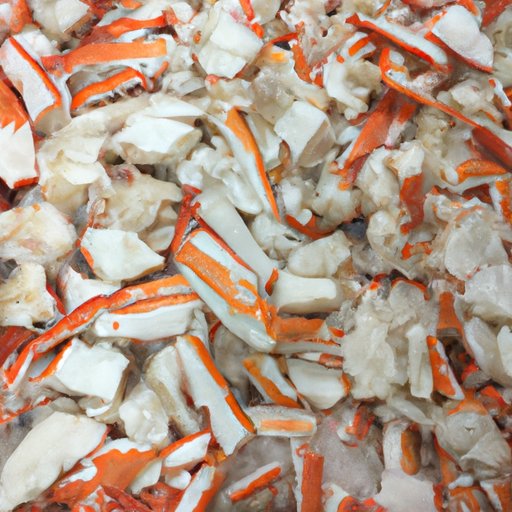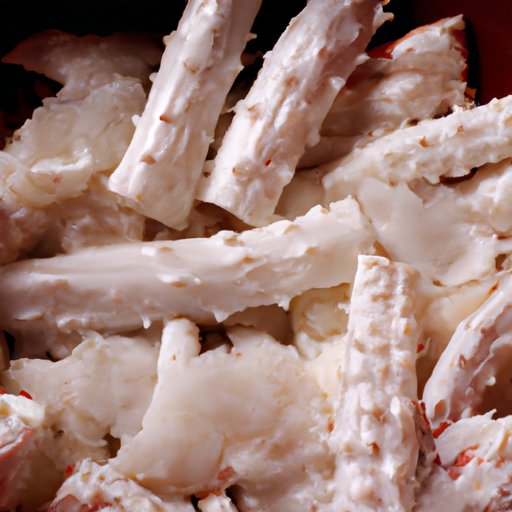
Introduction
Crab meat is a delicious and versatile ingredient that can be used in a variety of dishes, from salads to soups and stews. However, maintaining the freshness and quality of crab meat can pose a challenge, especially if you have more than you can consume in a short amount of time. Can you freeze crab meat? The answer is yes, but with certain caveats and considerations.
In this article, we will explore the ins and outs of freezing crab meat, including the best practices, tips, and potential drawbacks. Whether you are a seasoned chef or a beginner cook, understanding how to preserve crab meat through freezing can help you make the most of this delicious ingredient.
Crab Meat Preservation: Understanding the Freezing Process
Before we delve into the specifics of freezing crab meat, it’s important to understand how the process works. Freezing is one of the most effective ways of preserving food, as it slows down the natural decomposition of bacteria and enzymes that lead to spoilage. When you freeze crab meat, you essentially put it into a state of suspended animation, which means that it doesn’t continue to age or degrade like fresh crab meat would.
During the freezing process, the water in the crab meat turns into ice crystals, which can affect the texture of the meat. However, if you freeze the crab meat correctly, you can minimize these changes and preserve the quality of the meat for a longer period.
Most types of crab meat can be frozen, including cooked or raw, shelled or unshelled, and lump or claw meat. However, some types of crab meat may require different preparation methods to ensure maximum quality preservation.
To Freeze or Not to Freeze: Assessing the Pros and Cons of Keeping Crab Meat in the Freezer
If you have more crab meat than you can consume in a short amount of time, freezing can be a great option to extend its shelf life. However, it’s important to consider the potential drawbacks and trade-offs of freezing crab meat.
One of the biggest advantages of freezing crab meat is that it can extend its shelf life for several months, depending on the quality of the meat and the freezing conditions. This means that you can buy or catch crab meat in bulk and freeze it in portions for later use, making meal planning and prep more convenient.
However, freezing crab meat can also affect its texture and flavor. When the water in the meat turns into ice crystals, it can cause the meat to become tougher or mushier. Additionally, some of the natural flavors and aromas of the crab meat may be lost during freezing, leading to a less appealing taste. Lastly, freezing may not be ideal for all types of dishes or preparations, as some recipes may require specific texture or flavor profiles.
When deciding whether to freeze crab meat or not, consider the intended use and timeframe, as well as the factors that may affect its quality during freezing and thawing. For example, if you plan to use the crab meat in a recipe that relies heavily on the texture and flavor, freezing may not be the best option. However, if you just need a simple protein source for salads or sandwiches, freezing can be a convenient and cost-effective way to make the most of your crab meat.

Freezing Crab Meat: Best Practices and Essential Tips
If you decide to freeze crab meat, there are certain best practices and tips you should follow to ensure maximum quality and safety. Here are some essential tips and steps:
- Choose fresh and high-quality crab meat for freezing. Avoid using crab meat that has been previously thawed or has visible signs of spoilage or damage.
- Prepare the crab meat for freezing by removing any shells, cartilage, or debris that may affect the quality or safety of the meat. You can also season the meat with herbs, spices, or sauces before freezing, if desired.
- Package the crab meat in airtight containers or freezer bags, making sure to remove as much air as possible. Label the containers with the date and contents for easy identification later on.
- Place the packaged crab meat in the coldest part of the freezer, where the temperature is at or below 0°F (-18°C). Avoid placing the crab meat near the door or other sources of heat or temperature fluctuations.
- Thaw the frozen crab meat in the fridge or under cold running water, never at room temperature or in the microwave. Use the thawed crab meat within 2-3 days, and do not refreeze it.
Maximizing the Shelf Life of Crab Meat Through Freezing
While freezing can preserve the quality of crab meat, there are certain steps you can take to maximize its shelf life and ensure the best flavor and texture. Here are some tips on how to do that:
- Use fresh and high-quality crab meat for freezing, and avoid any meat that has been previously thawed or has visible signs of damage or spoilage.
- Choose the right type of crab meat for your recipe or preparation. Some types of crab meat, such as lump or claw meat, may be better suited for freezing than others.
- Properly package and label the crab meat for freezing, making sure to remove as much air as possible to prevent freezer burn.
- Thaw the crab meat using the recommended methods, and use it within the recommended timeframe.
- Consider using the thawed crab meat in recipes that may benefit from its texture and flavor changes, such as soups, stews, or dips.
On Deck for Crab Meat: Freezing Storage Options
When it comes to the containers or packaging for freezing crab meat, there are several options to choose from. Here are some pros and cons of each option:
- Plastic freezer bags: These are convenient and easy to use, and can be labeled and stacked easily. However, they may not provide as much protection against freezer burn as other options.
- Glass or plastic containers: These can be sturdy and reusable, and may provide better protection against freezer burn and breakage. However, they may take up more space in the freezer, and may not be as easy to stack or label.
- Vacuum-sealed bags: These can remove all the air from the package, preventing freezer burn and preserving the quality of the crab meat for longer periods. However, they may require special equipment to use, and may be more expensive than other options.
Each option may be more suitable for different situations or needs, depending on the amount of crab meat you have and how you plan to use it.
Exploring Alternatives to Freezing Crab Meat: What You Need to Know
If freezing crab meat is not an option or not preferable for your needs, there are other methods of preservation you can consider. Here are some pros and cons of each option:
- Canning: This involves sealing the crab meat in airtight jars or cans and boiling them to destroy any bacteria or enzymes. Canned crab meat can last for up to two years, making it a convenient option for long-term storage. However, canning may require special equipment and skills, and may affect the texture and flavor of the crab meat.
- Refrigeration: This involves keeping the crab meat in the fridge at a temperature between 32°F and 40°F (0°C to 4°C). Refrigerated crab meat is best used within a few days, but can last for up to a week if stored properly. However, refrigeration may not be as effective as freezing for long-term storage, and may also affect the texture and flavor of the crab meat.
Each option may be more suitable for different situations or needs, depending on the availability of equipment and the intended use of the crab meat.
Conclusion
Freezing crab meat can be a great way to extend its shelf life and make it more convenient to use in a variety of dishes and recipes. However, it’s important to understand the potential drawbacks and challenges of freezing, and to follow the best practices and tips to ensure maximum quality and safety. By following the steps and advice outlined in this article, you can make the most of your crab meat and enjoy it for longer periods.




